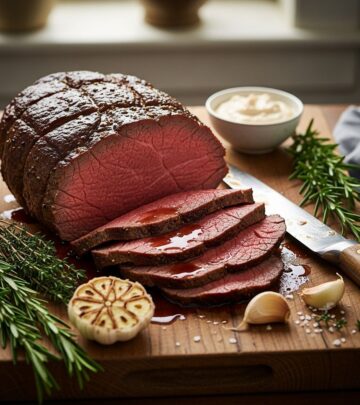The Beneventano: A Modern Italian Aperitif Cocktail Experience
A harmonious union of citrus, rhubarb and herbal spice elevates your aperitif experience.

The Beneventano: A New Classic in Italian Aperitif Culture
The world of aperitifs is ever-evolving, with creative bartenders continually reimagining classic liqueurs and regional specialties. At the crossroads of this trend is the Beneventano, a cocktail that elegantly fuses iconic Italian ingredients: Aperol, Zucca Rabarbaro, and Strega. While timeless in spirit, its balanced recipe and subtle flavors showcase a modern sensibility, making it the perfect drink for those seeking something deeply Italian yet refreshingly unique.
What Is the Beneventano?
The Beneventano is a modern cocktail creation named after Benevento, a southern Italian city famed for its production of the herbal liqueur Strega. This cocktail skillfully pairs the bittersweet, rhubarb-driven Zucca with the zesty, orange-forward Aperol. A modest dose of the mystical Strega ties these elements together, resulting in a drink that is strikingly aromatic, bittersweet, and low enough in alcohol to suit any aperitif occasion. Finished with a splash of soda and a fresh orange wedge, the Beneventano radiates both color and complexity.
Core Ingredients and Their Origins
Understanding the Beneventano begins with appreciating its signature ingredients—each a storied product of Italian distillation:
- Aperol: The Venetian aperitif that launched a thousand spritzes. Low in alcohol (11%), it mixes orange, gentian, rhubarb, and herbs for a bittersweet, vibrant flavor.
- Zucca Rabarbaro: A lesser-known but cherished Milanese amaro made from Chinese rhubarb root and aromatic herbs. Its bitterness and earthy depth are distinctive among amari.
- Strega: An enigmatic yellow liqueur from Benevento, made since 1860 with saffron, mint, and over 70 herbs and spices. Its name, meaning “witch,” refers to the town’s folklore and the liqueur’s magical aroma.
- Soda Water: Adds effervescence and lightness, ideal for opening up the intense liqueur flavors.
- Orange Wedge/Garnish: Brings brightness and makes the drink visually inviting.
The Flavor Profile: Tasting Notes and Pairing Suggestions
The Beneventano tastes as vibrant as it looks. Upon the first sip, expect these layered sensations:
- Bittersweet citrus and herbal notes from Aperol, setting a bright, juicy base.
- Intriguing earthiness and depth from Zucca, adding a smoky, rhubarb-powered bitterness.
- Exotic spice and complex aromatics from Strega, with a delicate hint of mint and saffron lingering on the palate.
Overall, the Beneventano is refreshingly bittersweet, with enough complexity to intrigue experienced drinkers but an inviting color and aroma for beginners.
Pairing suggestions: Serve the Beneventano with classic Italian antipasti. Think marinated olives, salted nuts, prosciutto-wrapped melon, or aged cheeses—the kind of fare that welcomes a lively aperitif.
Crafting the Beneventano at Home: Recipe & Method
| Ingredient | Amount | Notes |
|---|---|---|
| Aperol | 1 1/2 oz (45 ml) | Chilled |
| Zucca Rabarbaro | 1 1/2 oz (45 ml) | Can substitute Sfumato |
| Strega | 1/2 oz (15 ml) | For aromatics and balance |
| Soda Water | 1 splash | To taste |
| Orange Wedge | 1 | Garnish |
Instructions:
- Fill a double old-fashioned glass with ice.
- Add the Aperol, Zucca, and Strega. Stir gently to combine.
- Top with a generous splash of soda water.
- Garnish with a fresh orange wedge.
For a pitcher (serves 6), scale up each ingredient proportionally and stir over ice before topping with soda and garnishing glasses individually.
The Story Behind the Beneventano Cocktail
The Beneventano isn’t pulled from antique cocktail books, but is rather an inspired invention by contemporary bartenders passionate about Italian beverages. Its name pays homage to the town of Benevento, most famous for Strega, and to the broader tradition of regional Italian amaros and liqueurs. The mix of Aperol and Zucca references the vibrant contrast between northern and southern Italian drinking cultures, while Strega evokes the magical, herbal roots of the spirit world.
While the origins are modern, the Beneventano stands shoulder to shoulder with the great European aperitif cocktails, holding its own in flavor, sophistication, and story.
Understanding Italian Aperitifs: Aperol, Zucca, and Strega in Depth
Aperol
First produced by brothers Luigi and Silvio Barbieri in Padua in 1919, Aperol is the backbone of the famed Aperol Spritz but sings in more complex drinks as well. Its bittersweet taste comes from a secret blend of oranges, gentian, rhubarb, and cinchona, making it both approachable and refreshing.
Zucca Rabarbaro
Though not as ubiquitous as Aperol or Campari, Zucca is beloved by those who favor amari with pronounced herbal and smoky bitterness. Developed in 1845 in Milan, Zucca’s profile is defined by Chinese rhubarb root, which imparts its signature earthy tang, making it a favorite for those interested in vintage bar culture.
Strega
With a distinct yellow hue from saffron and an aroma filled with fennel, mint, and over 70 botanicals, Strega is one of Italy’s most legendary herbal liqueurs. Its nickname—the “witch’s liqueur”—hints at its place in Italian folklore, and its flavor adds a certain magical complexity to cocktails like the Beneventano.
Ingredient Substitutions and Cocktail Variations
- Zucca Alternatives: If Zucca is unavailable, try Sfumato Rabarbaro (a smokier Italian rhubarb amaro) for a similar, if deeper, profile.
- Strega Substitutes: In a pinch, Yellow Chartreuse may approximate Strega’s aromatic and herbal complexity, though with its own distinct character.
- Aperol Orange: For a more robust bitterness, Campari can be used in place of Aperol, though this will produce a stronger and darker cocktail.
- Soda: Any chilled sparkling water will work for the finishing touch of effervescence. For a sweeter spin, try tonic water and omit the orange wedge.
Serving Tips and Expert Approaches
- Ice Quality: Use large, clear ice cubes to slow dilution and maintain clarity.
- Pre-Chill Glassware: Keep glasses in the freezer for 20 minutes to ensure your Beneventano stays cool and refreshing longer.
- Batch Preparation: Mix Aperol, Zucca, and Strega in advance for parties. Add soda and garnish just before serving to retain carbonation and freshness.
- Creative Garnishes: Experiment with lemon twist, edible flowers, or a dash of aromatic bitters for a signature touch.
The Beneventano in Modern Cocktail Culture
Contemporary bartenders increasingly spotlight lesser-known spirits and amaros, offering drinkers an alternative to classic negronis and spritzes. The Beneventano encapsulates this shift: it is low-ABV, visually stunning, and encourages slow, convivial sipping. Its balanced composition means it appeals to both fans of bold Italian bitters and those who prefer gentle, floral aromatics with a touch of magic. As an aperitif, it’s ideal before meals, but its complexity and elegance make it equally sophisticated as a standalone refreshment for any time.
Frequently Asked Questions (FAQs)
Q: Is the Beneventano very bitter?
A: The cocktail is bittersweet rather than aggressively bitter, thanks to Aperol’s gentler profile balanced by Zucca’s earthiness and Strega’s smooth herbal notes.
Q: Can I substitute other Italian liqueurs?
A: Substitutions like Sfumato for Zucca or Yellow Chartreuse for Strega work well but may alter the final flavor balance.
Q: What ABV is the Beneventano?
A: Because all three liqueurs are relatively low in alcohol, especially Aperol, the finished cocktail is a lighter option—perfect for extended gatherings or pre-dinner drinks.
Q: Where can I find Zucca and Strega?
A: Both are increasingly available at well-stocked liquor stores specializing in amari or online, though sometimes Sfumato or other herbal liqueurs may be easier to source.
Q: Is the Beneventano suitable for batching for parties?
A: Absolutely! Multiply the recipe, stir with ice in a large pitcher, and top individual glasses with soda water and garnish just before serving for efficiency and freshness.
Final Thoughts: Why the Beneventano Belongs in Your Repertoire
The Beneventano occupies a special niche: sophisticated yet accessible, complex yet easy to mix. Its combination of Aperol, Zucca, and Strega demonstrates the versatility of Italian liqueurs while offering a flavor experience you won’t find in most bars. Perfect for those who appreciate bitter, herbal, and floral notes, the Beneventano redefines what an aperitif can be. Whether served solo or shared with friends over lively conversation and antipasti, this drink invites you to explore and savor Italian cocktail culture to its fullest.
References
Read full bio of Sneha Tete












